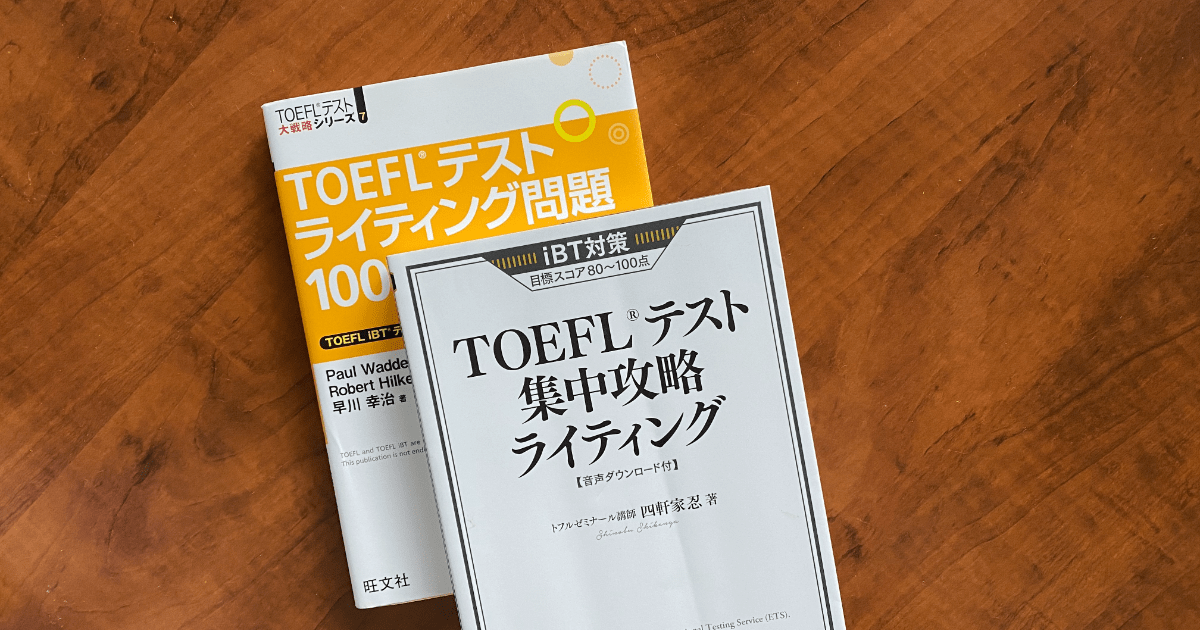【こちらは旧型式の情報ですので【新形式】TOEFL ライティング問題形式と対策法を参照ください】

TOEFLライティングの問題形式と対策法について紹介します。
TOEFL ライティングの概要とテンプレート
TOEFL ライティングセクションの概要を確認しておきましょう。
TOEFLのライティング問題は、2つのタスクで構成されています。
ライティングの試験時間は合計50分で、パート1は20分、パート2は30分で書きます。
パート1はIntegrated taskと言い、リーディング・リスニングとの統合問題です。
ライティングの力だけではなく、読解力・リスニング力も必要となるため、パート2よりも難しいと言えます。
パート2はIndependent taskと言い、ライティング力だけを測定する独立問題です。
コンピューターによるテストなので、標準の英語キーボード(QWERTY配列)を用いてタイプ入力をします。
速くタイプできるよう、苦手な人はタイピングの練習もしておきましょう。
タスク1とタスク2のテンプレートを暗記してお題が変わっても構成を崩さないようにしましょう。
TOEFLの他のセクションや、詳しい概要はこちら。

TOEFL ライティング問題形式別対策
パート1 Integrated task
Summarize the points made in the lecture you just heard, explaining how they cast doubt on the points made in the reading.
TOEFL Writing Part 1 問題例
TOEFL ライティングのパート1では、アカデミックなトピックについての文章を読んだ後、同じ話題についての講義を聞いて、それらの要点が対立しているか、サポートしているかなど、講義に関するポイントと関連性をまとめます。
ちなみに、リーディング・リスニングの要点は対立しているケースの方が多いです。
ライティング中、リーディングパートは画面の左側に、文字数と時間は画面の右上に表示されます。
リスニングはメモを詳しく取る必要があります。
制限時間は20分です。
文字数は 150~225 words と指定されていますが、TOEFLのライティングは文量を多く書く方が有利なので、250 words を目指しましょう。
制限時間20分の使い方は、リーディングに3分、リスニング約2分程度、残りの時間をライティングに使います。
| 解答時間(20分) | やること |
|---|---|
| 約3-5分 | メモを元にパッセージとレクチャーのポイントを対比させる 構成を立てる |
| 約15分 | 構成を元に書く |
| 約1-2分 | ケアレスミスの見直し |
パート1のポイント
- リーディングのフレーズをそのまま使わず、言い換えましょう(パラフレーズ)。
そのまま使うと、減点対象となります。 - 字数を稼ぐための、意味のない長いフレーズは避けましょう。
- リーディングの内容と、リスニングの内容を照らし合わせて構成を立てます。
- 最後に、文法ミスやスペルミスを確認する時間を作りましょう。
- メモを有効活用しましょう。
| リーディング | リスニング |
|---|---|
| 1. rewards improve productivity 2. it is proved by book 3. people need external motivating force 4. if structured well, reward system bring result | 1. people did not like it: they want to be given respect for working extra hard. 2. no controlled study prove that rewards increase productivity; studies show that rewards are contproductive 3. rewards punish. people do not want to be manipulated. 4. rewards worsen the relationships with supervisor |
パート1の採点基準
- リーディングパッセージとリスニングの関連性が正確に示されている
- 一貫性のある内容でまとまりがある
- 具体例がある
- 文法的間違いがなく、語彙の選択が適切である
パート1の構成&テンプレート
TOEFLのライティングは、イントロ・メイン1・メイン2・メイン3・結論の5段落構成にします。
イントロ:
リーディングのメインポイント(概要)を述べます。
リーディングの内容と、リスニングの lecturer との関連性(反対/賛成しているか)も述べます。
ボディ1:
リーディングの第1ポイントが、リスニングのレクチャーで反論(支持)されている内容
ボディ2:
リーディングの第2ポイントが、リスニングのレクチャーで反論(支持)されている内容
ボディ3:
リーディングの第3ポイントが、リスニングのレクチャーで反論(支持)されている内容
結論:
1~2行を使い、リスニングの中で反論もしくは賛成している内容を再び述べます。
パート1で使える便利なフレーズ
【イントロで使えるフレーズ】
- According to the passage, …
- Based on the reading, …
- The passage states/believes/describes that …
- In the reading, …
- The author of the passage explains/states/posits that …
- The author of the passage state with this idea/belief. Instead, he/she believes that …
【ボディ1・2・3で使えるフレーズ】
ボディ1・2・3では、各段落でリーディングとリスニングとの関係性について指摘します。
各段落の中の構成を以下のようにし、便利なフレーズを用いると書きやすくなります。
①リスニングのレクチャーが反論(支持)しているポイントが、リーディングではどのように書かれているかを述べる
ボディ1の書き出し
- First, the reading explains that ………….,
- First of all, the passage suggests/proposes that …
- First and foremost, the writer states that …
ボディ2の書き出し
- Second, the writer argues/contends/asserts that …
- Next, the passage suggests/proposes that …
- Another key point the writer makes is that …
ボディ3の書き出し
- Third, the writer explains/states that …
- Finally, the writing introduces the idea that …
- Lastly(Last but not least), the passage goes on to say that …
②リスニングではどのように反論(支持)されているか述べる
- In other words, the lecturer is suggesting/proposing that …
- The speaker, however, agrees/disagrees with this idea/belief, suggesting/proposing that …
- Similarly, the lecturer argues/contends/asserts that …
③段落のまとめ
- What this difference/similarity means is that …
- This difference/similarity in thinking tells us that …
- Evidently, the lecturer thinks/believes that … , whereas the author thinks/believes that …
【結論で使えるフレーズ】
- To sum up, this is how the listening passage casts doubt on the points made in the reading passage.
パート2 Independent task
TOEFL ライティングのパート2では、「公共の場での喫煙は禁じられるべきである。賛成か否か。」など、
与えられたトピックに賛成か反対か、自分の意見とその理由を3つほど述べる問題です。
パート1では、読んだり聞いたりした情報を「まとめる力」が必要とされる一方、パート2では、「自分の意見を文章にする力」が求められます。
制限時間は30分です。
文字数は最低でも 300 words とありますが、TOEFLのライティングは文量を多く書く方が有利なので、300-380 words を目指しましょう。
| 解答時間(30分) | やること |
|---|---|
| 約5-7分 | 自分の立場と裏付け内容の決定 構成を立てる |
| 約20-23分 | 構成を元に書く |
| 約2-3分 | ケアレスミスの見直し |
パート2の採点基準
- 問題に適切に答えているかどうか
- 論理的に議論を展開し、自分のアイデア・論点をサポートできているか
- 自分のアイデア・論点が、エッセイの結論と結びついているか
- 全体の構成
- 文法・語彙・ライティングの基本ルール(スペル・文法・大文字・小文字等)を含んだ英語の表現力があるかどうか
パート2 設問タイプ別の構成&テンプレート
パート2の採点基準のポイントを抑えるためには、しっかりした構成(ストラクチャー)が重要です。
ストラクチャーを理解し、使いこなし、本番までにある程度のストラクチャーを暗記しておくことが必要です。
パート2でも、パート1と同様にイントロ・メイン1・メイン2・メイン3・結論の5段落構成にします。
イントロ:定型文をできる限り使用し、時間と労力をかけない
ボディ1:メインアイデア1 時間と労力を使い、試験官にアピール
ボディ2:メインアイデア2 時間と労力を使い、試験官にアピール
ボディ3:メインアイデア3 時間と労力を使い、試験官にアピール
結論:定型文をできる限り使用し、時間と労力をかけない
設問タイプ① Do you agree or disagree with the following statement? (65%)
必ず、自分の意見がどちらの立場なのかを明確にしましょう。
The countryside is a better place to raise children than a large city.
TOEFL Writing Part 2 問題例 1-1
Do you agree or disagree with this opinion?
Use specific reasons and examples to support your position.
設問タイプ② Multiple Choice Style (15%)
二択・三択の中から自分の意見を選び議論を展開していきます。
Everyone faces challenges they have difficulty overcoming.
TOEFL Writing Part 2 問題例 1-2
These challenges are often related to our school life, our family life or our academic life.
What do you think is the best way to deal with a problem that is difficult to solve?
・Ask someone with more experience for help
・Finding more information about the problem using the internet
・Discussing the issue with a close friend
・Taking a long time to think about the problem
設問タイプ③ Preference Style/Paired Choice Style (15%)
どちらが良いかを選び、理由づけをきちんとしていきましょう。

設問タイプ④ Compare & Contrast essay
具体的な自分の意見が聞かれていない場合、イントロではこれから書くエッセイのプランを述べます。
A company has announced that it wishes to build a large factory near your community.
TOEFL Writing Part 2 問題例 2
Discuss the advantages and disadvantages of this new influence on your community.
Do you support or oppose the factory? Explain your position.
パート2で使える便利なフレーズ
- Personally, I believe A
- I am of the opinion that A
- I feel this way for two reasons; A and B / I feel this way for two reasons, which I will explore in the following essay
- First of all, / First,
- Secondary, / Second,
- Lastly, (Last but not least,) / Third,
- In conclusion / All things considered / To sum up / To conclude
- This is because A and B
TOEFL ライティングのコツ まとめ
- ライティングの試験だが、リーディング・リスニングのスキルも求められる。
- メモをうまく取れるように日頃から練習しておくべき。
- 書き始める前に、必ず構成を決めておくこと。
- 設問タイプごとの構成と、便利なフレーズを暗記しておく。
- ライティングは、指定されている語数よりも長めに書く。
- モデルアンサーも参考にしてみてください。



